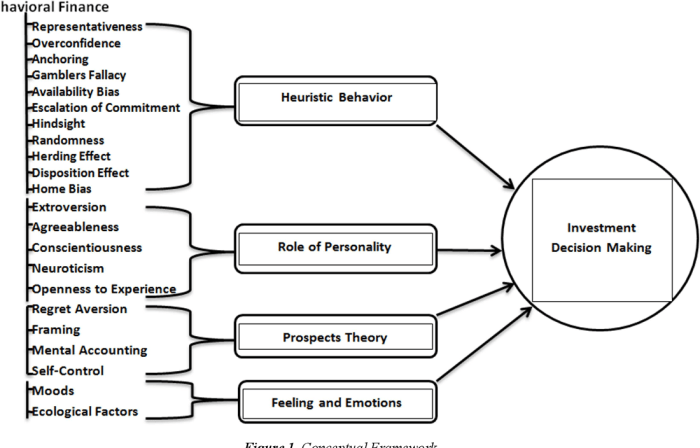Get ready to dive into the intriguing realm of Behavioral biases in investing, where our journey begins with unraveling the mysteries behind human behavior and its impact on investment decisions.
As we explore the various biases that influence our financial choices, you’ll uncover the hidden forces shaping the way we invest our hard-earned cash.
Introduction to Behavioral Biases in Investing
Behavioral biases in investing refer to the psychological tendencies or patterns that can influence an individual’s investment decisions, often leading to irrational choices based on emotions rather than facts or logic. These biases can impact how investors perceive information, assess risks, and make investment choices, ultimately affecting their overall portfolio performance.
Examples of Common Behavioral Biases
- Overconfidence Bias: Investors may believe they have superior skills or knowledge, leading them to take on more risk than they should.
- Loss Aversion: The fear of losses can cause investors to hold onto losing investments longer than they should, hoping for a rebound.
- Confirmation Bias: Investors tend to seek out information that supports their existing beliefs, ignoring contradictory evidence.
- Herding Behavior: Following the actions of the crowd without conducting independent research, leading to groupthink and potential investment bubbles.
Impact of Behavioral Biases on Investment Outcomes
Behavioral biases can have a significant impact on investment outcomes by distorting rational decision-making processes. They can lead to suboptimal asset allocation, missed opportunities, and increased portfolio volatility. Additionally, these biases can result in emotional trading, buying high and selling low, which can ultimately erode returns over time.
Overconfidence Bias
Overconfidence bias is a common phenomenon where investors tend to overestimate their knowledge, skills, or abilities when making investment decisions. This can lead to a false sense of security and a higher willingness to take risks without fully considering the potential consequences.
Examples of Overconfidence Bias
- Investors may trade more frequently than necessary, believing they have superior stock-picking abilities, leading to increased transaction costs and lower returns.
- Individuals may hold onto losing investments for too long, convinced that the market will eventually turn in their favor, resulting in significant losses.
- Traders might ignore diversification principles and put all their capital into a single stock, assuming they can accurately predict its future performance.
Counteracting Overconfidence Bias
- Conduct thorough research and gather diverse opinions before making investment decisions to gain a more balanced perspective.
- Implement a systematic investment approach with predefined rules and criteria to reduce impulsive and emotionally driven choices.
- Regularly review and analyze past investment decisions to identify patterns of overconfidence and learn from mistakes to improve future choices.
Loss Aversion Bias
Loss aversion bias is a behavioral tendency where individuals prefer avoiding losses over acquiring equivalent gains. In the context of investing, this bias can lead investors to hold on to losing investments for too long in the hope of avoiding realizing a loss.
Illustrate how loss aversion bias can prevent investors from making rational decisions.
Loss aversion bias can prevent investors from selling losing investments even when it is the logical choice to cut losses and reallocate funds to better-performing assets. This can result in missed opportunities for growth and overall portfolio underperformance.
Techniques to Mitigate Loss Aversion Bias
One technique to mitigate the effects of loss aversion bias is to set clear investment goals and risk tolerance levels before making any investment decisions. By establishing predetermined exit points for investments, investors can avoid being swayed by emotions when facing losses.
Another technique is to regularly review and rebalance investment portfolios. This process helps ensure that investments are aligned with the investor’s goals and risk tolerance, reducing the impact of loss aversion bias on decision-making.
Additionally, seeking advice from a financial advisor or mentor can provide an external perspective and guidance when dealing with the emotional aspects of investing. By having a trusted source of advice, investors can make more objective decisions based on their long-term financial objectives rather than short-term emotional reactions.
By implementing these techniques, investors can better manage the effects of loss aversion bias and make more rational investment decisions in line with their financial goals.
Herd Mentality Bias
When it comes to investing, herd mentality bias refers to the tendency of individuals to follow the actions of the majority without critically analyzing the situation. This can lead to investors making decisions based on the actions of others rather than their own research or analysis.
Real-World Impact
In financial markets, herd mentality bias can have a significant impact on asset prices. For example, if a large number of investors suddenly start buying a particular stock because of positive news or market trends, it can create a buying frenzy that drives the stock price up, regardless of the stock’s actual value.
- During the dot-com bubble of the late 1990s, many investors followed the herd and invested heavily in internet companies, causing stock prices to soar to unsustainable levels.
- Similarly, during the housing market bubble in the mid-2000s, the herd mentality led many individuals to invest in real estate, driving up prices to artificially high levels.
Risks of Following the Crowd
While following the crowd may sometimes result in short-term gains, it can also pose significant risks for investors.
- One major risk is the possibility of a market bubble forming, where prices are driven up to unsustainable levels before eventually crashing, leaving investors with significant losses.
- Additionally, herd mentality bias can lead to a lack of diversification in investment portfolios, as investors may all flock to the same assets or sectors, increasing their exposure to potential losses if those investments perform poorly.
Confirmation Bias
Confirmation bias is the tendency for individuals to seek out information that confirms their preexisting beliefs or opinions while ignoring or downplaying conflicting evidence. In investing, confirmation bias can lead investors to only consider information that supports their initial investment thesis, even if it may not be the most accurate or up-to-date.
Instances of Poor Investment Outcomes
- Investors only focusing on positive news about a company they are invested in, while disregarding any negative reports, leading to potential losses.
- Ignoring warning signs or red flags in the market because they contradict the investor’s bullish outlook, resulting in missed opportunities to adjust or exit positions before a downturn.
Methods to Avoid Confirmation Bias
- Seek out diverse sources of information and opinions to get a well-rounded view of an investment opportunity.
- Challenge your own beliefs by actively looking for evidence that contradicts your initial thoughts and hypotheses.
- Engage with a trusted advisor or mentor who can provide an objective perspective and challenge your assumptions.
Anchoring Bias

Anchoring bias is a cognitive bias where individuals rely heavily on the first piece of information they receive when making decisions. In the context of investing, this bias can cause investors to fixate on initial data or prices, even if they are no longer relevant, leading to skewed decision-making.
Significance in Investment Decision-making
Anchoring bias can significantly impact investment decisions by clouding judgment and preventing investors from adapting to new information or changing market conditions. For example, if an investor originally purchased a stock at $50 per share and the price drops to $30 per share, they may anchor their perception of the stock’s value to the initial price they paid, rather than objectively evaluating its current worth.
- Investors may hold onto underperforming assets longer than necessary due to anchoring bias, missing out on opportunities to reallocate their funds to more promising investments.
- When setting price targets or stop-loss orders, investors influenced by anchoring bias may base their decisions on irrelevant past prices, rather than focusing on current market trends and analysis.
- Anchoring bias can lead to missed opportunities for portfolio diversification or the failure to adjust asset allocations based on changing market conditions, ultimately hindering overall portfolio performance.
Strategies to Overcome Anchoring Bias
To overcome anchoring bias and make more informed investment decisions, investors can implement the following strategies:
- Regularly review and update investment thesis and goals to ensure decisions are based on current information and analysis, rather than past anchors.
- Utilize tools and techniques such as dollar-cost averaging or setting predetermined exit points to help mitigate the impact of anchoring bias on investment decisions.
- Seek guidance from financial advisors or engage in discussions with peers to gain different perspectives and challenge fixed beliefs or preconceptions about investments.






